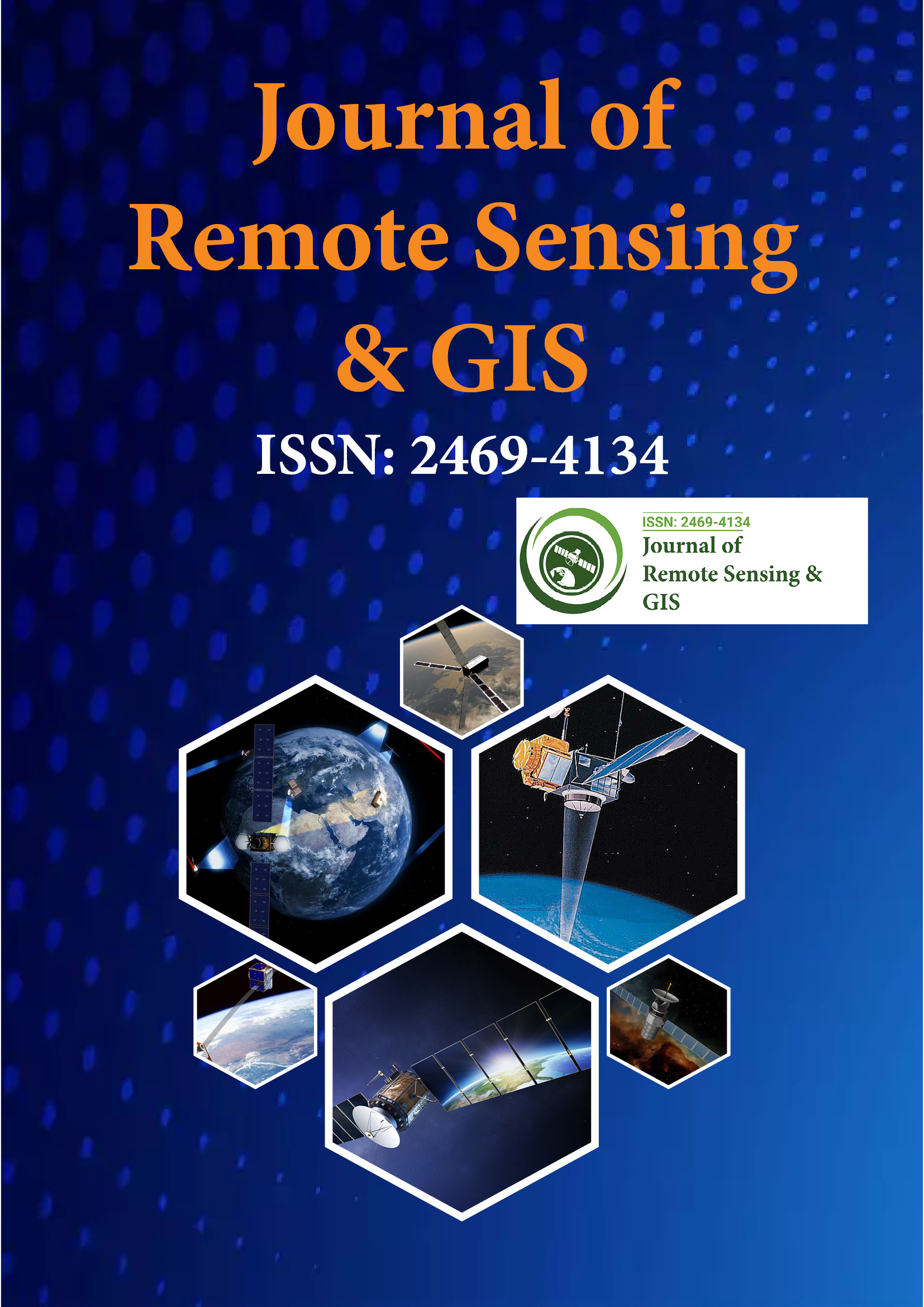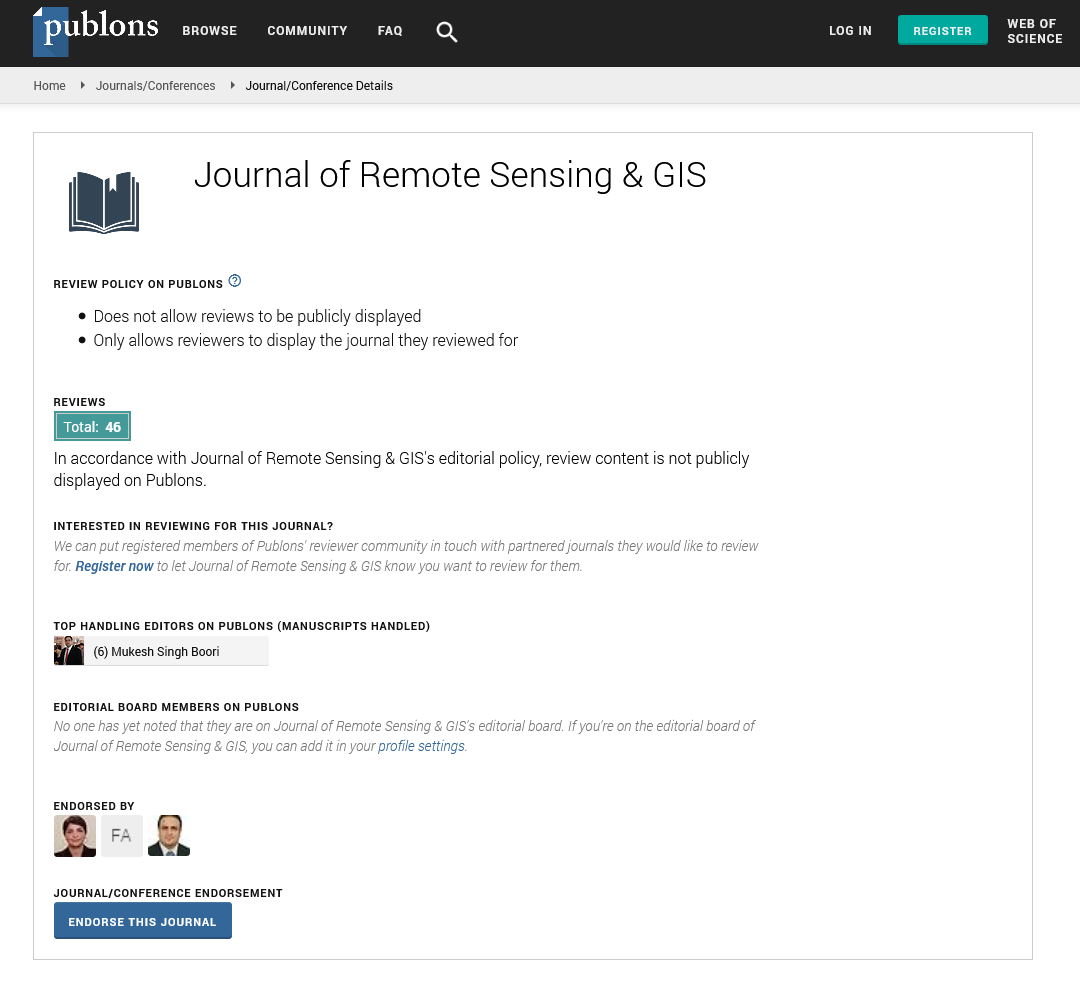Indexed In
- Open J Gate
- RefSeek
- Hamdard University
- EBSCO A-Z
- OCLC- WorldCat
- Publons
- International Scientific Indexing
- Euro Pub
- Google Scholar
Useful Links
Share This Page
Journal Flyer

Open Access Journals
- Agri and Aquaculture
- Biochemistry
- Bioinformatics & Systems Biology
- Business & Management
- Chemistry
- Clinical Sciences
- Engineering
- Food & Nutrition
- General Science
- Genetics & Molecular Biology
- Immunology & Microbiology
- Medical Sciences
- Neuroscience & Psychology
- Nursing & Health Care
- Pharmaceutical Sciences
Commentary - (2024) Volume 13, Issue 4
Advancing Space Technology: Applications and Innovations in Remote Sensing
Tian Chai*Received: 25-Nov-2024, Manuscript No. JGRS-24-28058; Editor assigned: 27-Nov-2024, Pre QC No. JGRS-24-28058 (PQ); Reviewed: 12-Dec-2024, QC No. JGRS-24-28058; Revised: 20-Dec-2024, Manuscript No. JGRS-24-28058 (R); Published: 27-Dec-2024, DOI: 10.35248/2469-4134.24.13.359
Description
Remote sensing has emerged as a key element of space technology, enabling the collection of valuable data about Earth's surface and atmosphere. By utilizing advanced sensor systems on- board satellites, remote sensing has transformed our ability to monitor, map and manage natural resources, environmental changes and human activities. Its applications span diverse domains, including agriculture, climate science, disaster management and urban planning, demonstrating its widespread utility and effectiveness.
The origins of remote sensing in space technology date back to the mid-20th century, with the launch of early Earth observation satellites like Landsat-1 in 1972. These missions covered the way for acquiring systematic data about the planet's surface and laid the foundation for modern remote sensing technologies. Over time, advancements in sensor design, image processing and satellite deployment have significantly enhanced the resolution, accuracy and scope of data collection.
Modern satellites are equipped with instruments such as multispectral, hyperspectral, thermal and radar sensors. These tools provide detailed information across different wavelengths, enabling comprehensive analysis of physical, chemical and biological properties of Earth's surface. The development of constellations of small satellites or CubeSats, has further improved temporal resolution, allowing for near real-time monitoring.
Principles of remote sensing
Remote sensing operates on the principle of detecting and interpreting electromagnetic radiation reflected or emitted from objects on Earth. Sensors aboard satellites measure radiation across various bands of the electromagnetic spectrum, including visible, infrared and microwave. The data is then processed to generate meaningful insights, such as land cover classification, vegetation health assessment and temperature distribution.
Active sensors, such as radar and LiDAR, emit their own signals and measure the reflection, while passive sensors rely on natural radiation, such as sunlight. Each type of sensor serves specific applications, making remote sensing versatile and adaptable to different needs.
Applications of remote sensing in space technology
Major applications of remote sensing in space technology are:
Environmental monitoring: One of the primary applications of remote sensing is tracking environmental changes. Satellites equipped with multispectral and hyperspectral sensors monitor deforestation, desertification and changes in water bodies. Thermal imaging is used to detect heat islands and assess forest fires, while radar sensors help in mapping soil moisture and analyzing glacier dynamics. These datasets support sustainable management of ecosystems and inform policies for conservation.
Agriculture and food security: Remote sensing plays a significant role in precision agriculture by providing data on crop health, soil conditions and water availability. By analyzing spectral signatures, farmers can optimize irrigation, fertilization and pest control. Satellites also track large-scale agricultural trends, enabling governments and organizations to predict food production and plan for potential shortages.
Disaster management: In disaster-prone areas, remote sensing provides timely information for risk assessment and response. Satellites detect early warning signs of natural hazards such as hurricanes, floods and volcanic eruptions. Post-disaster imagery aids in evaluating damage, planning relief efforts and rebuilding infrastructure. For example, Synthetic Aperture Radar (SAR) can capture surface deformations caused by earthquakes, even under cloud cover.
Urban planning and infrastructure: Urban areas benefit significantly from remote sensing data. High-resolution imagery helps in mapping urban growth, analyzing land use patterns and planning infrastructure. Urban heat islands, transportation networks and green spaces can be assessed to improve city design and resource allocation. Remote sensing also supports smart city initiatives by integrating geospatial data with IoT technologies.
Climate science: Remote sensing contributes extensively to understanding climate change. Satellites monitor greenhouse gas concentrations, sea level rise and polar ice melting. By providing long-term datasets, they facilitate the study of trends and anomalies in climate systems. Instruments such as spectro- radiometers and radiometers measure parameters like temperature, humidity and radiation fluxes, offering insights into atmospheric processes.
Exploration of celestial bodies: Beyond Earth, remote sensing is instrumental in exploring other planets, moons and asteroids. Spacecraft equipped with remote sensing instruments analyse surface compositions, geological features and atmospheric conditions of celestial bodies.
Technological advancements and trends: The field of remote sensing continues to evolve with innovations in satellite technology, data processing and machine learning. Miniaturization of sensors and advancements in propulsion systems have enabled the deployment of large satellite constellations, enhancing coverage and temporal resolution. High-throughput satellite networks ensure faster data transmission and processing, making real-time applications feasible.
Conclusion
Artificial intelligence and machine learning have revolutionized data analysis by automating pattern recognition and anomaly detection. These technologies extract meaningful insights from vast datasets, enabling efficient monitoring and prediction. Cloud computing platforms further streamline access to remote sensing data, facilitating collaboration among researchers, policymakers and industry stakeholders. Integration with other emerging technologies, such as the Internet of Things (IoT), has expanded the scope of remote sensing. IoT devices on the ground provide complementary data to satellite observations, creating a comprehensive geospatial framework for decision- making. Moreover, advancements in drone technology offer flexible and localized remote sensing capabilities, connecting the gap between ground-based and satellite-based observations.
Citation: Chai T (2024). Advancing Space Technology: Applications and Innovations in Remote Sensing. J Remote Sens GIS. 13:359.
Copyright: © 2024 Chai T. This is an open-access article distributed under the terms of the Creative Commons Attribution License, which permits unrestricted use, distribution and reproduction in any medium, provided the original author and source are credited.

